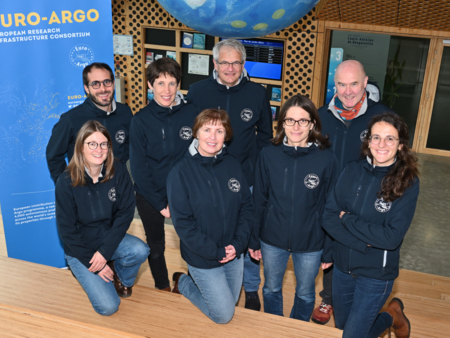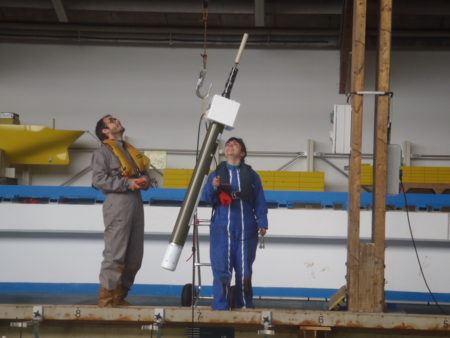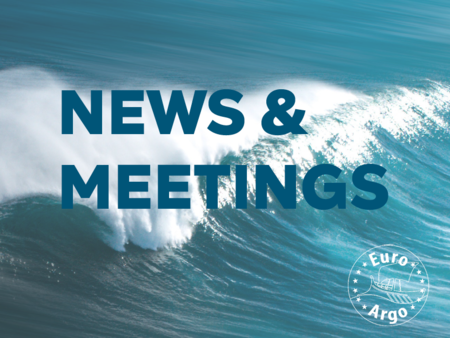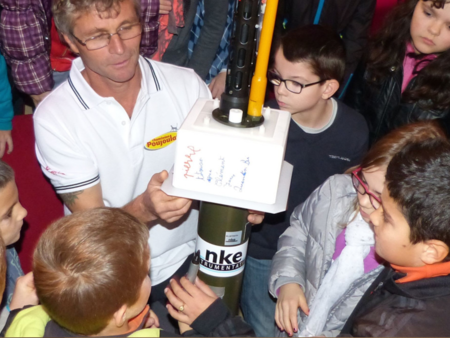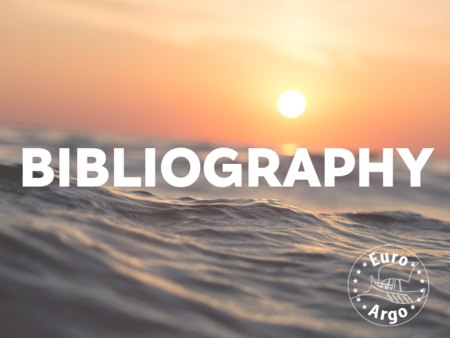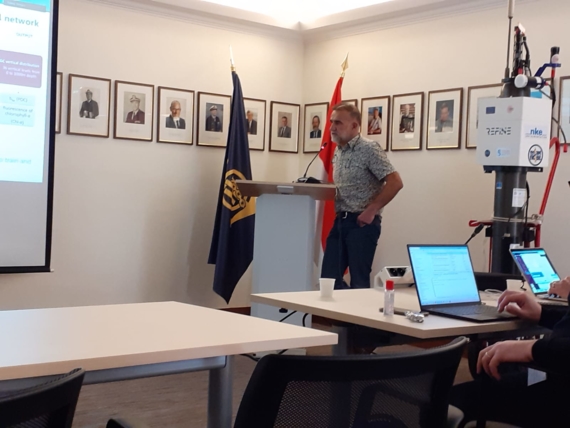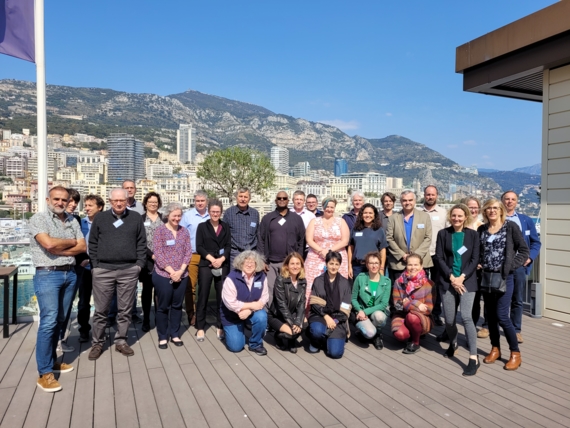AST-23 Meeting - Monaco March 2022
The 23rd AST meeting was organised in Monaco on 21-25 March 2022, during the Monaco Ocean Week, as a hybrid event.
In addition to the usual sessions, as part of Monaco Ocean Week, a public lecture was made by S. Wijffels and H. Claustre and a UN Ocean Decade Forum was organised, which objective was to bring together observing networks (e.g. GO-SHIP, AniBOS, etc.) and their data users to better understand both the needs of the users and to communicate the networks strategies and services.
The AST23 meeting report and slides of the presentations are available HERE.
Many discussions were held on all aspects in link with the Argo programme during the week. The main conclusions and recommendations from an Euro-Argo point of view are described hereafter.
Implementation
- Several challenges faced in the implementation of the OneArgo array were highlighted and discussed:
- Some regions are under-sampled compared to others, such as the Indian Ocean where float deployments lack. The need for coordination at basin level was raised and 2 Task Teams were formed to progress on this issue: one for the Indian Ocean and one for the Atlantic Ocean;
- Sensor and platform quality, supply and timeliness;
- Covid and inflation have translated into major price increases for floats and sensors;
- The stress on Data Assembly Centres is high and a need to prioritise their activities was pointed out;
- The reliability of data quality has decreased and the community needs to be vigilant and work closely with the manufacturers in that regard;
- As the OneArgo mission costs 3 times the original mission, there is a need for additional funding sources in the coming decade. Moreover, it is a priority to maintain the core Argo array at its current level and to find ways to translate research funding to operational funding. There was general agreement that Deep and BGC float lifetimes need to improve, and the study carried out on float life expectancy within Euro-Argo RISE was mentioned. This study reviews floats performances across models and missions, with focus on Euro-Argo specificities (marginal seas, etc.). Such studies should be pursued and used to guide Argo floats deployments, configurations and management.
- BGC mission
More than 70 papers were published in 2021 on BGC-Argo. Regarding implementation, the network is progressing, with about 200 active floats with 5 or more sensors and strong (funded) commitments over the next 5 years for about 800 floats to be deployed with five or six sensors.
A group led by Emanuele Organelli (CNR) reported on their work on the configuration of radiometry measurements. They tend to recommend that all BGC, 4-channel radiometers standardise on wavelengths of 380, 443, 490, and 555 nm. They are also recommending 1-m sampling resolution where possible.
- Deep mission
Three Deep Argo pilot arrays will be implemented in the Pacific, Atlantic, and Indian oceans in 2022. The deployment rate (53 floats) for 2022 is just enough to maintain the regional Deep Argo arrays, and represents only 17% of the yearly value needed to implement the global 1200 Deep Argo float array. Only nine national programs buy Deep Argo floats, although other partners are contributing to the mission by helping in data management, float deployments and on other technical aspects. A paper describing the strategy for the global implementation of the Deep Argo array will be submitted for publication in August 2022.
- Polar Argo
A report was made by Ingrid Benavides on behalf of the teams working in polar regions, and it was decided to form a Polar mission team, such as for the BGC and the Deep missions, with terms of reference. This team will work on technical and data problems and refine the scientific design.
- Sampling strategies
A Working Group has been working on identifying the best sampling configurations over the past year, and presented their recommendations:
- All Argo floats should be set to sample at approximately 10 days (ie 10.08 days, but not a divisor of 24 hours), drift at 1000m and profile to 2000m, whenever possible. The goal is to obtain an even distribution of surfacing time. In general, floats should not sample on the same time of the day for each profile.
- This approximate 10-day sampling should be implemented on all floats in the future. For some float types, this may mean a change in the manufacturer’s default settings prior to deployment. [The ERIC Office has prepared a list of floats for which the cycle time is suggested to be updated].
- Present floats using some other protocol yielding non-uniform sampling should be changed to the approximate 10-day protocol as soon as it is feasible, using two-way communication (if possible).
- Float users and manufacturers should work together to ensure that these changes are implemented in the proper manner.
BGC variables were also examined for preferred sampling time and some (NO3, pH) had no preference, while O2 and FLBB would prefer the dark and the radiometer has a strong desire for noon sampling. This was the strongest preference and the group came up with the following recommendations to accommodate this preference:
- Add one full 0-2000m noon profile per month. This would be an additional profile and all surrounding profiles would stay with regular sampling strategy.
- Flag these profiles in the database so that they can be easily removed if not wanted for certain studies.
- Set the radiometer to sample at the maximum practical rate near the surface during ascent.
The final topic considered was park-level sampling and here are the group’s recommendations:
- All BGC-Argo floats should sample temperature, pressure and FLBB (or equivalent) hourly during the park-phase.
- Salinity and nitrate would be useful, but they consume too much energy for this to be practical.
- The radiometer could also provide useful sampling during park depth, but more discussion is needed.
Data Management
ADMT
The outcomes of last ADMT meeting were summarised by Sylvie Pouliquen :
- The Argo Data System is great but managed by human beings with their limits. We collectively have to define priorities to streamline the activities.
- Argo Data System has been able to evolve to handle new missions but not all elements are yet fully defined, nor implemented on sustained fundings. New man power and expertise need to be devoted to the OneArgo data system both on method development and on implementation.
- No platform/sensor is perfect and monitoring data quality is essential to anticipate actions when a failure is detected. It is essential to extend to ALL variables tools similar to what exist for T & S and run operationally ideally on a monthly timescale.
- Argo data are managed and used by new communities and we should, like we used to do 20 years ago, organise training and outreach workshops/materials to facilitate new actors’ engagement and new user Argo uptake.
Sylvie is retiring in 2022 and therefore, with Megan, she has been looking for a new co-chair to take over: Claire Gourcuff, from the Euro-Argo ERIC office, accepted to take over and everybody welcomed her as new co-chair of the ADMT.
RBR DATA
The recent agreement reached at the ADMT meeting in December 2021 to flag post-April2021 RBR salinity (from core RBR sensors) with PSAL_QC=’1’ in real-time, if all real-time QC tests were passed, was recalled. This means that the Argo community recognizes that the RBR CTDs have improved to a point where their raw salinity data can be treated equally in real-time as the other CTD data in Argo.
It is now recommended for groups procuring floats to include part (10%, 25% or more) of the fleet equipped with an RBR CTD to progress in the implementation and further assess the quality of the CTD data on Argo floats.
VNS BODC
Progress made on making the Argo data and metadata system more 'FAIR' (Findable, Accessible, Interoperable and Reusable) as part of the ENVRI-FAIR H2020 EU project was reported by Violeta Paba (BODC). Current work is focused on turning remaining Argo reference tables into controlled vocabularies (using the NERC Vocabulary Server - NVS) with unique URLS accessible by humans as well as machines, and new vocabularies are being created by the wider Argo data management community to constrain currently free-text or loosely regulated Argo NetCDF metadata variables. In 2022 it’s important that the GDAC filechecker use Argo Vocab to strengthen the checking of file format entering the Argo repository.
Technical aspects
- The series of short meetings organised as part of Euro-Argo RISE to foster links with Argo manufacturers were reported by Brian King (NOC). These 6 meetings (with one manufacturer for each meeting) were very well welcomed by all participants and provided a chance for vendors or users to talk about anything that either side wanted to raise. A common recurring theme was the effort required by DACs to compile float metadata in a format that could be entered into NetCDF files. The vendors all expressed a willingness to engage on this topic with a view to providing: (i) machine-readable metadata (minimum requirement), (ii) machine-to-machine metadata (preferable), (iii) decoders that provide a DAC with tech and profile data with vocabulary close to what the DAC must upload to the GDACs, and which don’t change with minor float firmware revisions.
- Platform & sensors were reviewed, including new available instruments and developments. First data obtained by the 3-headed Deep-Arvor and two 2-headed Deep-Arvor floats deployed in March 2022 to validate the evolutions of the RBR 6000m CTD, as part of the Euro-Argo RISE project were also presented.
- Abrupt Salinity Drift (ASD): On behalf of the working group, Birgit Klein gave an update on the floats affected by ASD, showing updates from the comparison of raw float data against climatology (CARS/MIMOC) by SN cohorts, which confirms the issue for SN cohorts 6000-7000, 8000-9000 and 10482-11252. Beyond these ranges, the occurrences of salty drift are few and random, with the caution that younger floats with SN >11252 have not accumulated long time series yet. Similar findings were obtained from a spreadsheet on abrupt salty drift operated jointly by all DMQC-operators which contains around 660 entries at the moment with some DMQC still pending. About 11% of all PSAL cycles are affected at the moment. Preliminary horizontal maps show a uniform distribution of the cycles over all ocean basins and no specific spatial patterns. Instructions from the last ADMT to DMQC operators were reiterated: ‘Float salinity data from the ASD phase should be considered as bad and unadjustable’.
- Argo deployments in EEZ: Operations in EEZ were discussed by Mathieu Belbeoch, as it is still a challenge for all Argo national programmes to deploy floats within areas under national jurisdiction such as the EEZs, representing a third of the ocean surface. The use of Article 247 of UNCLOS could offer some interesting developments. For ocean observing programmes implemented under international organisations umbrella (which is the case for Argo with IOC/UNESCO and WMO), this article could enable to gather coastal states consent through a consolidated implementation plan submitted by the international organisation. This should be discussed at the next session of the IOC-UNESCO Executive Council in June 2022, hoping a regional pilot will be encouraged. OceanOPS will propose a best practices document on this topic within the Euro-Argo RISE project.
Community engagement
Over the 5 days of meetings, the need to reinforce the links between Argo and the modelling and satellite communities were stressed several times. A Working Group was set up to progress on this issue, and an action was created to work on data products delivered by Argo dedicated to these communities.
Denmark was invited to present its recent involvement in Argo and its representatives were warmly welcomed in the Argo community.
The progress made by the Core Argo Best Practice working group was presented, with a paper in preparation that should be submitted to community review in summer 2022.
The Argo Tech Community of Practice working group led by Pat McMahon was presented. This group targets technicians and people directly involved in preparing floats for deployment, and its main motivation for forming the group was to create a space for shared ideas and collaboration in the technical sphere. Anyone interested in joining the group is invited to contact pat.mcmahon(at)csiro.au.
Progress made on the preparation of the 7th Argo Science Workshop to be hosted by Euro-Argo in Brussels on 11-13 October 2022 was reported by Claire Gourcuff. A call for volunteers from Asia or from the BGC-Argo community was reiterated.
Finally, the outcomes of the 2nd Ocean Observers educational workshop jointly organised by OceanOPS and Euro-Argo in November-December 2021 were highlighted by Emanuela Rusciano (OceanOPS).
Euro-Argo also had the opportunity to present all the work carried-out and the results obtained in the framework of the Euro-Argo RISE H2020 EU project, which has contributed, since its start in 2019, to significantly progress in all aspects of the Argo programme.

